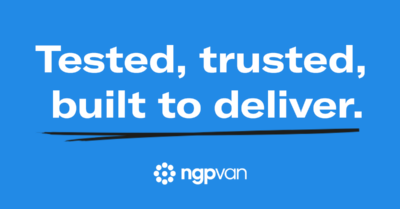How to run a successful political campaign in 7 steps

Running for political office is an empowering, worthwhile endeavor — but the process can be intimidating, especially if you’re new to politics. That’s why it’s important to have a thorough understanding of how to run a political campaign before you officially declare your candidacy.
Whether you’re running for local office or embarking on a federal campaign, reviewing the steps involved in running a political campaign will help you prepare to build a campaign plan and execute it to help you win your race.
1. Know why you’re running and articulate it well
Before you assemble a team or start making plans, it’s crucial to define exactly why you’re running for office. Do you want to improve local public schools? Do you believe your state legislature needs more diverse voices that represent the interests of the community? Or something else?
Think through your motivations and develop clear, refined stances on issues that resonate with voters. Then, solidify the story you will tell about yourself, your campaign, and your community, making sure to address these questions:
- What problems are you trying to solve?
- How are those problems personal for you?
- What unique qualities, knowledge, and perspectives do you offer?
- How will you create thoughtful and effective policy if elected?
- Why is now the right time to run for office?
Once you have articulated your vision and values on paper, brainstorm ideas for a few stances on key issues that can serve as central messaging for your campaign across a variety of communication channels. These stances will then allow you to ensure consistent communication during voter and donor outreach, speeches, debates, and more. Test these messages to see if they resonate with voters and donors and refine them if necessary. Repeat the process until you have clear, concise messages that can serve as the basis of your political campaign messaging.
2. Conduct research
Next, you’ll need to find more information about the regulations, voters, issues, and opponents that make up the political landscape in your jurisdiction. This knowledge is key to understanding the likelihood of your campaign’s success and will help you ground any initial ideas you have about your campaign in reality.
In particular, you should research:
Ballot access and campaign laws
Start by researching the ballot access laws for the office you plan to run for. Ensure that you meet all the requirements to run for office, which may include being over a certain age, residing in the area for a certain length of time, and more. Ballot access laws vary by jurisdiction and election level, so make sure you know which laws apply to your campaign.
Then, find out the steps you need to take to get on the ballot. Filing to run for office can require anything from fees to a certain number of signatures from the community and more. Contact your relevant election authority to ensure you meet filing requirements and deadlines and know other important dates for the upcoming election cycle.
Before you raise any money for your campaign or cause, you need to know what campaign finance laws you must follow. Campaigns should create separate campaign bank accounts to ensure that funds are kept separate from personal funds. Make sure to check with your relevant election authority to understand what you must do before you start fundraising for your campaign to avoid any violations or fines.
Your vote goal
Once you’ve clarified that you’re eligible to run for office, determine how much support you need to win by calculating a vote goal.
Use past election results to estimate voter turnout and multiply that percentage by the total number of voters in your jurisdiction. Then, multiply the result by 50% and add one to find out how many votes would constitute a simple majority (assuming you’re in a two-person race).
This might look like:
- 0.42 [expected voter turnout] x 15,263 [registered voters] = 6,411 expected votes
- (6,411 [expected votes] x .50) + 1 = 3,206 votes needed to win
Your vote goal (or win number) will drive many decisions you make for your campaign – from the number of doors you knock to the number of mailers you send. Calculating this number early will help you make decisions that inform other parts of your campaign plan (like how much money you need to raise and how many voters you need to contact).
Target voters
With your vote goal in mind, determine who your target voters are. These target voters are often split into two different universes (or groups): persuasion and mobilization targets. Persuasion targets may include swing voters who always vote or voters who may not typically vote for Democrats or progressives, but you need to pull some of their votes to hit your win number. Mobilization targets are likely to support your campaign, but you need to get them out to vote. For instance, mobilization universes often include likely or identified Democrats who do not vote in every election. You will likely split your time between these two groups, but your allocation of that time is totally up to your campaign. For instance, if your district is split between Republicans and Democrats, you may want to spend more time speaking with voters in your persuasion universe compared to someone in a district that votes 60%+ for Democrats.
Once you know which voters to target, frame your messaging and script to them, but listen to their concerns. To be able to effectively serve your community, you first need to hear your community. Educate yourself on the issues that impact your district and its voters by speaking with voters directly, reading community reports and news, and paying attention to online conversations about relevant topics. Ask voters about their experiences and the issues they care about most to determine if you need to shift your messaging and to better inform your outreach in the future.
The opposition
Finally, research the candidates you’ll be running against. Find out what platform they’re running on and how voters feel about them. If you’re running against an incumbent, review their public records for any controversial policies or laws they supported that you can leverage in campaign ads or debates. No matter who your opponents are, you should find as much information on them as you can so you’re prepared to face them in the race and use the information when necessary.
3. Form your campaign team
Whether you have the resources to hire experienced staff or rely on volunteer support, every successful candidate can be helped by a core campaign team that can help you strategize, fundraise, and conduct voter outreach.
To form this team, you’ll likely need to leverage your personal network along with the networks of a few key supporters (unless you can afford to hire out help immediately). If you’re looking for volunteers, reach out to friends, family, and other personal connections to ask if they’d like to personally get involved or know others who would be a good fit for your team. To hire more experienced staff, leverage political job boards, professional connections, and local political parties and elected officials to help find and interview candidates.
The roles you need to fill will vary depending on the scale and budget of your campaign, but they may include:
- A campaign manager who manages staff and oversees the campaign’s operations
- A field director who is in charge of leading voter outreach efforts
- A volunteer coordinator who handles volunteer recruitment, communication, and management
- A fundraising director or team that leads efforts to raise money, host fundraising events, and manage donor relations
- A communications director or team that takes charge of marketing and public relations
- A finance director and a treasurer who are in charge of your budget, spending, and compliance with campaign finance laws
While that’s not an exhaustive list of people that you’d ideally have on your campaign team, you also may not need all of them to succeed. Most campaigns can benefit from a campaign manager, treasurer, and volunteer coordinator to help drive most of their operations forward, but it’s helpful to find others to help if they can.
4. Create a detailed campaign plan
Your campaign has one main goal: getting enough votes to win your race. To orchestrate a victory, however, you’ll also need to raise money, organize volunteers to engage voters, communicate your message through multiple channels, and more. Managing all of these moving parts requires a comprehensive campaign plan.
While your campaign plan is a living document that you should refer to and refresh frequently throughout the election cycle, you should do your best to document and plan as much as you can before launching your campaign to set yourself up for success. By having a document to refer back to, you should make it easier on yourself during the busy election season when you have to make important decisions about your campaign.
In addition to the work we’ve already discussed, create a detailed document that covers important aspects of your campaign, including:
A finance plan with goals and fundraising strategies
It’s difficult to run a competitive campaign if you don’t have the financial resources you need to win. A comprehensive finance plan will help you detail what you plan to raise and spend throughout the election cycle, help you track your fundraising progress, and identify if your spending is on or off track. Your finance plan will also detail what fundraising strategies you plan to use to raise money for your campaign and how much you plan to raise from them.
A communications plan with a refined message
Return to the initial campaign message you developed in step one and refine it based on what you learned from your research. If you learned that your target voters care most about a specific aspect of the issue you want to address, for example, adjust your message to highlight how you can solve the problem. Or, if your opponent is running on a similar platform, find ways to make your message stand out and appeal more to undecided voters.
Determine how you will get that message out to voters through paid and organic channels like mailers, social media, email, and other channels, and how often you will send those communications. Figure out what social media platforms you will use and how often you will post to them. By making these decisions now, you establish a baseline that you can build upon during the election season if you have the resources to do so.
A field plan with voter outreach strategies
Securing the votes you need will require a variety of outreach methods and a passionate group of volunteers (or paid staff). Outline how your campaign will approach:
- Door-to-door canvassing: When volunteers knock on doors, talk to voters personally, and promote your campaign to voters in specific areas.
- Phonebanking: When staff and volunteers call individual voters to talk about your campaign and encourage them to vote.
- Get Out the Vote (GOTV): Targeted mobilization efforts to convince voters to get out and vote.
- Email and SMS outreach: Email and text messages crafted and sent strategically to connect with supporters and promote the candidate throughout your campaign.
With targeted outreach across multiple communication channels and on the ground, you increase the chances of connecting with supporters and encouraging them to take action for your campaign.
A campaign timeline and content calendar
A campaign timeline or calendar helps team members stay on track and visualize where your campaign is going. Your timeline will shift as the campaign gets underway, but having a general roadmap to guide you will help your team navigate changes.
Include key dates like your public campaign launch,voter registration deadlines, early voting times, and any other important dates. Then, broadly determine when volunteer recruitment, organizing, fundraising, and other campaign efforts should take place. Additionally, you can include important deadlines for team members and dates you aim to reach certain milestones to monitor progress.
In addition to your campaign timeline, it’ll be helpful to develop a content calendar to share when you’ll publish posts on social media, send emails, launch your website, publish new content on your website, and other related digital efforts. Having a separate calendar will help make it easier to see your content cadence compared to other dates within the election calendar.
Which political campaign tools you’ll use
Campaigning shouldn’t involve an endless number of spreadsheets — investing in the right campaign software saves you time, helps you run more efficient campaigns, and gives you an edge against opponents. For instance, with political CRMs, your team can update and access supporter information in real time, allowing you to pull reports and manipulate information to best serve your campaign strategy.
You can also invest in specialized tools to streamline and improve digital outreach. For example, modern email tools can help you reach more donors and boost efficiency by:
- Tracking how many people engage with your emails, as well as how much money an individual email has raised you across your supporter base — letting you learn from your victories (and mistakes).
- Segmenting contacts. For example, you might use segmentation to email past donors a fundraising email and those who have attended a past canvassing event an email with upcoming canvassing dates.
- Automatically sending welcome emails and follow-ups to new contacts. You can also use automation to schedule future emails and send confirmation and thank-you messages to people who’ve donated, signed up or attended an event, and more to touch base with supporters and try to get them more involved with the campaign.
Determine which tools your campaign should prioritize and how much room you have in your budget for campaign technology. Consider investing in digital outreach tools, canvassing apps, voter databases, and fundraising software to set your campaign up for success.
5. Design your campaign website
Next, use your refined campaign message to create promotional materials, starting with a campaign website.
When you announce that you’re running, people will likely go online to learn more about your campaign. A professional website is the best way to convert online interest and traffic into actionable data on which you can build an active supporter base. Include intuitive, usable forms that allow you to connect with people who are willing to donate, volunteer, or learn more about your campaign.
Additionally, your website needs to tell your campaign’s narrative effectively enough to reach voters and mobilize their support. Consider creating a campaign video, quoting volunteer testimonials about why they believe in your campaign, and using photos and graphics that represent the core points of your message.
Once your website is ready for the public eye, use the same logo and brand identity you used to create other campaign materials like social media graphics, posters, buttons, and more. Ensure all campaign materials are cohesive by using consistent branding and link back to your website when possible. And make sure to add required disclaimers to your collateral when needed!
6. Fundraise early and often
At its core, fundraising is about building relationships and helping potential donors see themselves as part of the story of your campaign. Use a combination of the following methods to ask supporters to financially support your campaign early in the cycle:
- Call time fundraising: Recruit staff and volunteers to call potential donors and explain your campaign to them one-on-one. Ask volunteers to note any concerns or priorities prospects have so you can tailor fundraising asks in the future.
- Fundraising events: Consider planning a few events where you can get to know supporters and form personal connections. Depending on your needs and budget, events can be intimate gatherings, large parties, or anything in between.
- Online fundraising: Your website and online communication channels will be essential for marketing your campaign to potential donors. Set up a donation page on your website so supporters can easily make contributions online.
To track all of your fundraising efforts, it’s wise to invest in a political fundraising database so you don’t leave any money on the table. Using a political fundraising database allows you to easily pull lists from your database for targeted donor outreach, follow up on outstanding pledges and calls, file accurate campaign reports, and more. Plus, by using a fundraising database early, you can learn how to make the most of it before election season heats up. And by asking your donors to give early, you can ask them to give again later in the cycle too!
P.S. As you use the above methods or conduct any other fundraising activities, ensure that you follow all relevant campaign finance laws for your jurisdiction.
7. Launch your political campaign
After following these steps, you should be well on your way to developing your full campaign plan and officially launching your campaign. Plan to use multichannel outreach to launch your campaign and get the word out as widely and quickly as possible. Consider channels like social media, email, text messaging, live streaming, and more to help boost fundraising and attendance before, during, and after your launch. Make sure each outreach channel and related messages are fully thought out and planned well before your launch.
As an example, you might declare your candidacy on social media a few weeks before you host an in-person launch party to build up momentum. To boost your fundraising and attendance numbers, you could send texts and emails to supporters before the event to ask them to join you and donate to your campaign. When launch day arrives, you can live stream the launch party on your website or on social media. No matter which channels you use, make sure your entire team is prepared to start connecting with voters and donors to kickstart your political campaign!
Run a successful political campaign with NGP VAN
Every step of running a political campaign can be made easier with the right resources. NGP VAN is the leading software provider for Democratic and progressive campaigns, helping candidates across the country raise more money, mobilize supporters, and ultimately win elections with the most trusted platforms in the progressive political industry. Learn how our tools can help you win your race.



